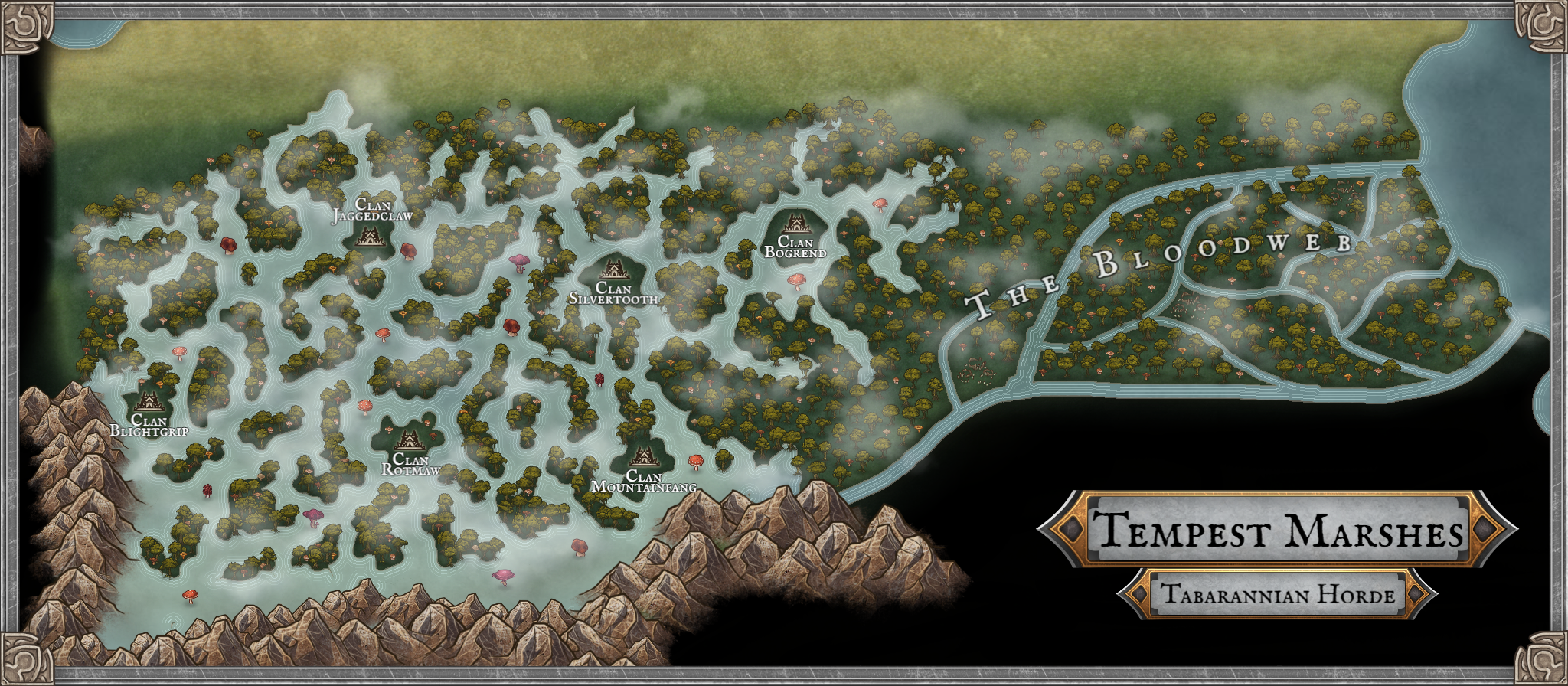
The Tempest Marsh
Geography and Climate
The Tempest Marshes occupy a broad depression bordered by mountainous ridges to the south and west. These ridges collect and redirect moisture, creating constant precipitation and mist formation across the region. The terrain is predominantly composed of silt, peat, and decaying vegetation, resulting in an uneven substrate with alternating elevated hummocks and deep sink areas.
Hydrologically, the area maintains a continuous layer of standing water, varying in depth from a few centimeters to several meters depending on rainfall. During wet seasons and high tides, the marshes merge into a single, semi-submerged plain. Storms are frequent, and electrical activity is common due to unknown supernatural origins.
Ecology and Enviroment
The Tempest Marshes sustain a dense and layered biosphere adapted to near-constant humidity, unstable ground, and periodic flooding. Root systems of native trees form both structural support and natural filtration networks, stabilizing the terrain. The decomposition rate of organic matter is rapid, leading to nutrient-rich but oxygen-poor soil conditions.
The region’s constant electrical storms and shifting water levels contribute to an unusual ecological phenomenon: many native species exhibit high memory retention and sensory adaptation, a product of both environmental pressures and selective evolution.
Enviromental Hazards
Frequent storms, unstable footing, and toxic flora pose consistent threats to both local inhabitants and outsiders. Some plant species excrete corrosive or poisonous sap, notably a copper-leaf plant whose toxic and antidotal varieties are visually distinct only by leaf shape. Additionally, the wither rose, pollinated by blight bees, produces a sap that accelerates organic decay.
Waterborne diseases are frequent due to stagnant conditions, and the terrain’s rapid flooding can isolate entire areas within hours, creating crowd control effects, mazes and frequently situations where pray is cornered by predator.
The Bloodweb is known by many civilizations as abnormally hazardous, some even view it as sacred.
Overview
Home to the people of the Tabaraanian Horde. The Tempest Marshes are a low-lying wetland region characterized by near-permanent flooding, seasonal storm activity, and extensive waterlogged terrain. The region forms part of a larger humid belt influenced by Torrent, known locally as the divine breath of The Tempest, whose climatic effects define the landscape. The marshes are among the most hydrologically complex areas on the continent, consisting of shallow channels, mud basins, and interconnected pools that sustain a dense but unstable ecosystem.
While the Tempest Marshes contain several valuable natural resources—including resilient hardwoods such as Marblewood and medicinal fungi like Obsidian Chaga, the environment’s instability, toxicity, and isolation make sustained exploitation highly impractical. The region’s natural hazards outweigh its economic benefits for most civilizations, rendering it strategically unappealing despite its resource potential.
Bloodweb Delta
To the east, the Tempest Marshes transition into a deltaic expanse known as the Bloodweb, where distributary channels spread toward the open coast. The region’s name derives from the distinct red coloration of its waters and sediment. While the hue originates partly from chemical deposits and decomposing organic matter, the intensity and persistence of the coloration are linked to a supernatural contaminant, a residual corruption believed to stem from a darker source. This influence alters the mineral composition of the soil and water, producing ocassional mild necrosis on local vegetation and fauna with extended exposure.
The Bloodweb’s terrain is unstable and densely vegetated, with frequent ground subsidence and deep silt beds. The remnants of former more advanced Troll settlements lie scattered throughout, partially submerged beneath water and overgrowth. These ruins form both nesting grounds and anchor points for aggressive arachnid species unique to the delta.
Among these, the Titan Spiders are of particular note. Either existing as a single large species or a cluster of related subspecies, they display elevated territorial aggression and rapid web construction. Their silk integrates naturally with the delta’s crimson sediment, giving their webs a red-hued translucence that renders them nearly invisible under natural light. The webs span between tree buttresses and collapsed structures, often extending across waterways. The spiders’ presence has made deeper traversal through the Bloodweb hazardous even for native inhabitants.
Indigenous Inhabitants
The region is primarily inhabited bypredominantly barbaric Troll populations who have developed cultural and architectural adaptations to the swamp environment. Dwellings are built on stilts or raised mud platforms to avoid flooding. Water transport is achieved through narrow, shallow-hulled boats propelled by floor-dragging paddles that allow movement through both water and mud. These boats are regarded for their maneuverability in confined channels.
The environmental demands of the Tempest Marshes have contributed to notable cognitive developments among its inhabitants, particularly strong spatial memory and environmental mapping skills, aiding navigation through the unstable landscape.




